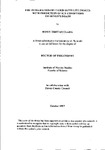THE INTEGRATION OF CLOUD SATELLITE IMAGES WITH PREDICTION OF ICY CONDITIONS ON DEVON'S ROADS
| dc.contributor.author | CLARK, ROBIN TRISTAN | |
| dc.contributor.other | Faculty of Science and Engineering | en_US |
| dc.date.accessioned | 2013-09-18T11:26:25Z | |
| dc.date.available | 2013-09-18T11:26:25Z | |
| dc.date.issued | 1997 | |
| dc.identifier | NOT AVAILABLE | en_US |
| dc.identifier.uri | http://hdl.handle.net/10026.1/1844 | |
| dc.description.abstract |
The need for improved cloud parameterisations in a road surface temperature model is demonstrated. Case studies from early 1994 are used to investigate methods of tracking cloud cover using satellite imagery and upper level geostrophic flow. Two of these studies are included in this thesis. Errors encountered in cloud tracking methods were investigated as well as relationships between cloud height and pixel brightness in satellite imagery. For the first time, a one dimensional energy balance model is developed to investigate the effects of erroneous cloud forecasts on surface temperature. The model is used to determine detailed dependency of surface freezing onset time and minimum temperature on cloud cover. Case studies from the 1995/96 winter in Devon are undertaken to determine effects of differing scenarios of cloud cover change. From each study, an algorithm for predicting road surface temperature is constructed which could be used in future occurrences of the corresponding scenario of the case study. Emphasis is strongly placed on accuracy of predictions of surface freezing onset time and minimum surface temperature. The role o f surface and upper level geostrophic flow, humidity and surface wetness in temperature prediction is also investigated. In selected case studies, mesoscale data are also analysed and compared with observations to determine feasibility of using mesoscale models to predict air temperature. Finally, the algorithms constructed from the 1995/96 studies are tested using case studies from the 1996/97 winter. This winter was significantly different from its preceding one which consequently meant that the algorithm from only one scenario of the 1995/96 winter could be tested. An algorithm is also constructed from a 1996/97 winter case study involving a completely different scenario Recommendations for future research suggest testing of existing algorithms with guidance on additional scenarios. | en_US |
| dc.description.sponsorship | Devon County Council | en_US |
| dc.language.iso | en | en_US |
| dc.publisher | University of Plymouth | en_US |
| dc.title | THE INTEGRATION OF CLOUD SATELLITE IMAGES WITH PREDICTION OF ICY CONDITIONS ON DEVON'S ROADS | en_US |
| dc.type | Thesis | en_US |
| plymouth.version | Full version | en_US |
| dc.identifier.doi | http://dx.doi.org/10.24382/1362 |
Files in this item
This item appears in the following Collection(s)
-
01 Research Theses Main Collection
Research Theses Main


